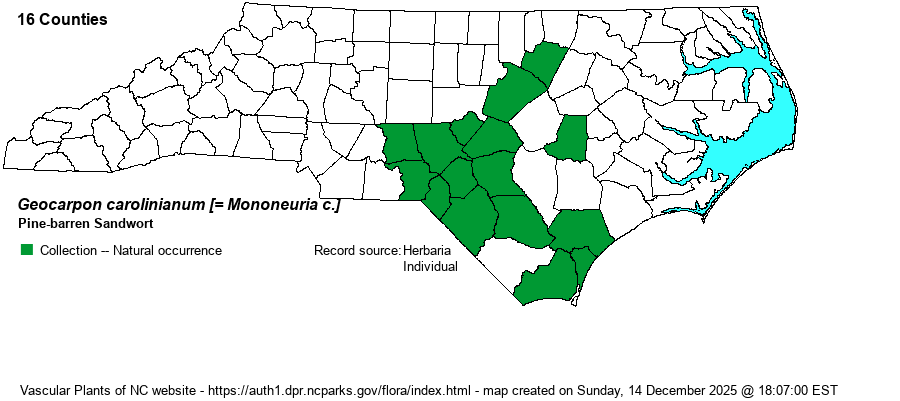| Author | (Walter) E.E. Schilling | |
| Distribution | Occurs over the southwestern portions of the Coastal Plain, mainly in the Sandhills region. Ranges north to Franklin and east to Wayne and Pender counties.
This is an Atlantic Coastal Plain species, ranging from Long Island, NY, south to the FL Panhandle. It is quite disjunct, barely occurring in MD, VA, and northeastern NC.
| |
| Abundance | Frequent to common in the Sandhills region; locally uncommon to infrequent eastward to coastal counties, and quite rare in the northern counties in the range. | |
| Habitat | This is not just a Sandhills species, it is a species of deep sands, inhabiting the most xeric sites in the state. It occurs in Xeric Sandhill Scrub, on fluvial sand ridges, sand rims of Carolina bays, and other deep sandy places. |
| Phenology | Blooms from April to June, and fruits shortly after flowering. | |
| Identification | This is a semi-woody plant, with a thick taproot, and with a sprawling stem or stems. It has very numerous pairs of awl-like or short, needle-like leaves, each being only about 1/4-inch long, stiff and very dark green. Several tall (about 2-3 inches high) flowering stalks have a few flowers at the tips of short branches; each flower has 5 white petals and a spread of about 3/4-inch across -- moderately large for such a matted plant. Though seemingly quite unique in deep sands, there are a few other species with awl-like leaves growing in sandy places, such as Phlox nivalis and a few species of Hypericum. You should be able to encounter this unusual species in the Sandhills region, less so in southern coastal counties. It can occur in sizable mats, and when in bloom such a mass of matted vegetation is quite a spectacle. | |
| Taxonomic Comments | This species has been moved around from genus to genus in recent years. For most of the last century, it was named as Arenaria caroliniana, with many other native species at that time. It has since been moved to Minuartia, as M. caroliniana, and now many list it as Mononeuria caroliniana. And, in 2022, Schilling moved most of the genus now to Geocarpon. Weakley (2022) has followed this latest move -- certainly not the last!
| |
| Other Common Name(s) | Carolina Sandwort, Longroot, Pine-barren Stitchwort | |
| State Rank | S3S4 | |
| Global Rank | G5 | |
| State Status | | |
| US Status | | |
| USACE-agcp | | |
| USACE-emp | | |

